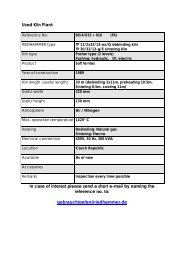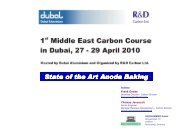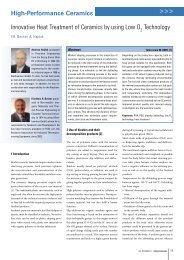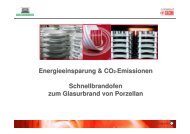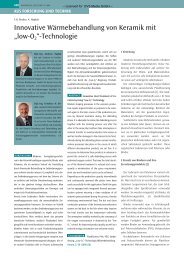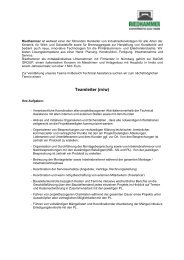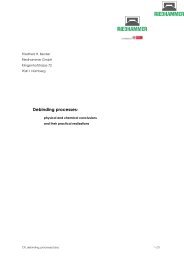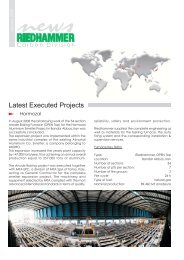Baking furnaces for anodes of highest quality - Riedhammer
Baking furnaces for anodes of highest quality - Riedhammer
Baking furnaces for anodes of highest quality - Riedhammer
You also want an ePaper? Increase the reach of your titles
YUMPU automatically turns print PDFs into web optimized ePapers that Google loves.
Originally published in<br />
ALUMINIUM • 7-8/2012, pages 32-35<br />
<strong>Riedhammer</strong> GmbH<br />
<strong>Baking</strong> <strong>furnaces</strong> <strong>for</strong> <strong>anodes</strong><br />
<strong>of</strong> <strong>highest</strong> <strong>quality</strong><br />
7/8<br />
Volume 88 · July / August 2012<br />
International Journal <strong>for</strong> Industry, Research and Application
A L U M I N I U M S M E L T I N G I N D U S T R Y<br />
<strong>Riedhammer</strong> GmbH<br />
<strong>Baking</strong> <strong>furnaces</strong> <strong>for</strong> <strong>anodes</strong> <strong>of</strong> <strong>highest</strong> <strong>quality</strong><br />
<strong>Riedhammer</strong> GmbH with headquarters in<br />
Nuremberg, Germany, has many years’<br />
experience in the carbon business stretching<br />
right back to its founding in 1924.<br />
The company’s reference list is impressive:<br />
it includes well over 200 orders <strong>for</strong><br />
<strong>furnaces</strong> <strong>for</strong> producing electrodes, cathodes<br />
and <strong>anodes</strong>. The largest complete<br />
order to date was received in 2008; it was<br />
<strong>for</strong> an anode baking furnace <strong>for</strong> the Kazakhstan<br />
Aluminium Smelter (KAS) and the<br />
project was finalised in 2012.<br />
Until the middle <strong>of</strong> the last decade, <strong>Riedhammer</strong><br />
had specialised in closed-type anode<br />
baking <strong>furnaces</strong>. Following its acquisition <strong>of</strong><br />
open-top technology from Alesa in 2005,<br />
<strong>Riedhammer</strong> is the only independent company<br />
worldwide that supplies both open-top<br />
and closed-type anode baking <strong>furnaces</strong>. Today,<br />
open-top ring pit <strong>furnaces</strong> are the predominant<br />
system <strong>for</strong> new<br />
projects but there are still<br />
a lot <strong>of</strong> closed-type anode-baking<br />
<strong>furnaces</strong> in<br />
operation worldwide<br />
that <strong>Riedhammer</strong> repairs<br />
and modernises, or<br />
can rebuild as open-type<br />
<strong>furnaces</strong> if required.<br />
The company completed<br />
such a conversion<br />
at Trimet in Hamburg in<br />
2011. “That was a very<br />
interesting project <strong>for</strong> us,”<br />
says Thomas Janousch,<br />
business unit director <strong>of</strong><br />
the Carbon Division at<br />
<strong>Riedhammer</strong>. “It was a<br />
complete order covering<br />
not only the engineering<br />
but also the supply <strong>of</strong><br />
materials and the execution<br />
<strong>of</strong> the refractory<br />
lining on site. The project was completed in<br />
record time: the existing furnace tub was demolished<br />
in April and the furnace, including<br />
construction <strong>of</strong> the tub and extension <strong>of</strong> the<br />
foundations was completed in December.”<br />
The new 48 section anode-baking furnace<br />
increased the capacity <strong>of</strong> the Hamburg Trimet<br />
carbon plant by 50%, to 120.400 tonnes<br />
a year. It is capable <strong>of</strong> supplying high-<strong>quality</strong><br />
<strong>anodes</strong> to Trimet’s smelters in Hamburg<br />
and Essen. The furnace has six pits per section,<br />
three fire groups, a fire cycle time<br />
<strong>of</strong> 26 hours and is fuelled by natural gas.<br />
Carbon is the most important area <strong>of</strong> business<br />
at <strong>Riedhammer</strong>, accounting <strong>for</strong> some 30<br />
to 50% <strong>of</strong> turnover depending on the actual<br />
project situation. Within the Carbon Division,<br />
the anode sector accounts <strong>for</strong> the largest share<br />
<strong>of</strong> the business, or at least has done so in recent<br />
years. <strong>Riedhammer</strong>’s corporate structure<br />
enables the company to react very flexibly to<br />
large orders. As and when required, the division<br />
can call upon the resources <strong>of</strong> other technical<br />
departments.<br />
<strong>Riedhammer</strong>’s carbon business comprises<br />
three business units: Anodes (mainly opentype<br />
baking <strong>furnaces</strong>), Electrodes / Cathodes<br />
(closed-type baking <strong>furnaces</strong>) and, more intensively<br />
since 2011, Special Carbon (here<br />
<strong>Riedhammer</strong> <strong>of</strong>fers car bottom <strong>furnaces</strong><br />
or small closed-type ring pit <strong>furnaces</strong>). “An<br />
added reason why the Special Carbon business<br />
is interesting <strong>for</strong> us is that we can call<br />
upon the expertise <strong>of</strong> our Technical Ceram-<br />
<strong>Riedhammer</strong>’s scope <strong>of</strong> supply <strong>for</strong> an anode baking facility<br />
ics division when it comes to the car bottom<br />
furnace (second firing <strong>of</strong> electrodes). As the<br />
anode business is very cyclical, this ensures a<br />
steady order intake and an even workload in<br />
the department,” says Mr Janousch.<br />
Whereas the electrode business is geared<br />
to the steel industry, cathode baking <strong>furnaces</strong><br />
are used to produce the cathodes used in<br />
aluminium electrolysis. This is a limited business<br />
because unlike <strong>anodes</strong>, which are consumed<br />
continuously during the electrolysis<br />
process, cathodes have a service life <strong>of</strong> several<br />
years.<br />
Range <strong>of</strong> contracts: from modernisation<br />
projects to installation <strong>of</strong> complete units<br />
The most extensive contract involving a <strong>Riedhammer</strong><br />
anode baking furnace comprises the<br />
whole <strong>of</strong> the engineering with the associated<br />
specifications, the supply and installation <strong>of</strong><br />
the refractory materials <strong>for</strong> the furnace and<br />
all <strong>of</strong> the ancillary equipment, such as firing<br />
system, furnace tending assembly, transport<br />
system, etc.<br />
For new anode projects, <strong>Riedhammer</strong> now<br />
only <strong>of</strong>fers open-top baking <strong>furnaces</strong>. “For<br />
the same anode <strong>quality</strong> it can be operated at<br />
faster fire cycle and thus has a higher output.<br />
In addition, emissions are lower because the<br />
combustion in the flue walls has been opti-<br />
mised in recent years,” explains Mr Janousch.<br />
The market <strong>for</strong> new anode baking <strong>furnaces</strong><br />
and the modernisation <strong>of</strong> existing plant has<br />
been somewhat depressed <strong>for</strong> quite some time<br />
as a result <strong>of</strong> the extremely<br />
low prices <strong>for</strong> primary<br />
aluminium. By contrast,<br />
2011 was a mark-<br />
edly successful year <strong>for</strong><br />
the Carbon Division.<br />
In March 2011 Hindalco<br />
awarded <strong>Riedhammer</strong><br />
a contract <strong>for</strong><br />
the engineering <strong>of</strong> a<br />
new anode baking furnace<br />
with 34 sections,<br />
to be built at its smelter<br />
complex in Renukoot,<br />
India. The open-top<br />
furnace is designed<br />
with nine pits per section<br />
and an annual<br />
production <strong>of</strong> 140,000<br />
tonnes <strong>of</strong> baked <strong>anodes</strong>.<br />
The engineering<br />
was completed in<br />
mid-2011 and the civil<br />
works started at the end <strong>of</strong> last year. Refractory<br />
lining is scheduled to be completed in the<br />
fourth quarter <strong>of</strong> 2012, and commissioning<br />
will be early in 2013.<br />
At Dubal, the refractory material <strong>of</strong> an<br />
existing baking furnace was replaced and the<br />
furnace relined; this meant replacing all <strong>of</strong> the<br />
flue walls and some <strong>of</strong> the headwalls. Prior<br />
to modernisation, the furnace had achieved a<br />
service life <strong>of</strong> 180 fire cycles without any <strong>of</strong> the<br />
flue walls being replaced. Dubal was obviously<br />
more than satisfied with the work carried out<br />
by <strong>Riedhammer</strong> because it honoured the com-<br />
ALUMINIUM · 7-8/2011
Images: <strong>Riedhammer</strong><br />
S P E C I A L<br />
pany with an award <strong>for</strong> excellence in <strong>quality</strong>.<br />
In addition, as mentioned above, <strong>Riedhammer</strong><br />
carried out a conversion at Trimet in<br />
Hamburg; it also carried out the installation<br />
and commissioning <strong>for</strong> Kazakhstan Aluminium<br />
Smelter (KAS) in Pavlodar.<br />
KAS is the only aluminium smelter in<br />
Kazakhstan, which lies in central Asia near<br />
the border to China. The electrolysis plant<br />
was built during the first phase in 2007, albeit<br />
without an anode plant at that time. The<br />
capacity <strong>of</strong> the smelter was doubled in the<br />
middle <strong>of</strong> 2010, to 250,000 tpy.<br />
For the KAS project, <strong>Riedhammer</strong> undertook<br />
the complete planning <strong>of</strong> the anode<br />
baking facility, supplied the whole plant and<br />
subsequently commissioned it. KAS was thus<br />
<strong>Riedhammer</strong>’s most comprehensive order to<br />
date <strong>for</strong> the complete installation <strong>of</strong> an anode<br />
baking facility. The order covered three par-<br />
tial contracts:<br />
• 2008: the engineering package<br />
• 2009/10: the supply <strong>of</strong> materials and<br />
equipment comprising refractories, firing<br />
system, two furnace tending assemblies,<br />
anode transport system with anode<br />
cleaning machine and the fume treatment<br />
plant<br />
• 2011: the contract to install at site the<br />
material and equipment supplied and to<br />
commission the baking furnace facility.<br />
“What was special about this project <strong>for</strong> us<br />
was that we acted as the general contractor.<br />
There was no EPCM contractor between us<br />
and the client as is <strong>of</strong>ten the case with large<br />
projects. Instead, we took on this role ourselves<br />
and processed the whole order working<br />
directly with the client,” says Mr Janousch.<br />
The scope <strong>of</strong> supply included the baking<br />
furnace (refractory material), the firing sys-<br />
ALUMINIUM · 7-8/2011<br />
tem, the fume treatment plant, the furnace<br />
tending assemblies and the anode handling<br />
system (conveyors and anode cleaning machine).<br />
“This was without doubt one <strong>of</strong> the<br />
most important projects <strong>Riedhammer</strong> had ever<br />
undertaken given its commercial significance<br />
and our objective <strong>of</strong> promoting and establishing<br />
open-top technology as well as supplying<br />
complete solutions,” adds Mr. Janousch.<br />
The furnace has 50 sections, with seven pits<br />
per section. There are three fire groups with a<br />
fire cycle time <strong>of</strong> 23.5 hours. The unit is fuelled<br />
by heavy oil and has an annual production capacity<br />
<strong>of</strong> 150,000 tonnes <strong>of</strong> baked <strong>anodes</strong>.<br />
The project was demanding given the climatic<br />
conditions prevailing in Kazakhstan: winters<br />
with ‘Siberian’ temperatures that can go down<br />
to -48 °C and summers where the thermometer<br />
can soar to 45 °C. Timing was there-<br />
Anode-baking furnace at KAS. The sections shown in the photo are filled with green anode that is<br />
covered by a layer <strong>of</strong> petroleum coke to prevent the anode burning<br />
<strong>for</strong>e something that had to be kept in mind.<br />
Erection <strong>of</strong> the equipment started at the end <strong>of</strong><br />
May 2011, and the firing system and furnace<br />
tending assembly were handed over to the<br />
client early in December, after which the furnace<br />
drying out began. Refractory lining <strong>of</strong> the<br />
furnace had been carried out between June<br />
and November 2011. The conveying system,<br />
second furnace tending assembly and the fume<br />
treatment plant were handed over in February<br />
2012. Production started at the end <strong>of</strong> March,<br />
and the first baked anode was unloaded in<br />
April. The complete anode baking facility,<br />
engineered, delivered and built by <strong>Riedhammer</strong>,<br />
was handed over to the client in May<br />
2012.<br />
Mode <strong>of</strong> operation <strong>of</strong> a baking furnace<br />
An open-type anode baking furnace like the<br />
one at KAS comprises 50 sections, each <strong>of</strong><br />
A L U M I N I U M S M E L T I N G I N D U S T R Y<br />
which has seven pits enclosed within eight flue<br />
walls. The furnace is fired from the top via<br />
the flue walls and the flue gas transfers heat<br />
to the refractory material and the <strong>anodes</strong>. The<br />
<strong>anodes</strong> are baked to a temperature <strong>of</strong> about<br />
1,100 °C.<br />
The flue walls are meander-like. The exhaust<br />
gas is channelled through the flue walls<br />
via three baffles be<strong>for</strong>e being channelled via<br />
the headwall to the next flue wall. In this way,<br />
the whole volume <strong>of</strong> exhaust gases passes<br />
through all <strong>of</strong> the sections and heats up the<br />
baking furnace.<br />
There is a partial vacuum in the system<br />
which drives the fumes towards the exhaust.<br />
At the outlet <strong>of</strong> the furnace, the flue gas has a<br />
temperature <strong>of</strong> 250 to 350 °C, it is then transferred<br />
to the fume treatment plant.<br />
Depending on the production and the<br />
furnace construction, the fire is moved after<br />
22 to 32 hours; at KAS the fire cycle time is<br />
23.5 hours. A fire covers 16 sections: three<br />
sections in preheating, the burner bridges are<br />
positioned on three following sections (main<br />
fire), and six sections are being cooled. In this<br />
way, 12 sections are effectively standing in<br />
the heating flue. During this time, one section<br />
is being unloaded, two sections are empty, in<br />
order to carry out maintenance work (e. g. to<br />
sealing <strong>of</strong> expansion joints), and a further section<br />
is being loaded. At KAS, the baking furnace<br />
is equipped with 50 sections, two more<br />
than actually necessary, in order to allow the<br />
client more time <strong>for</strong> maintenance due to the<br />
fast fire cycle.<br />
The per<strong>for</strong>mance <strong>of</strong> the baking furnace is<br />
tailored to the per<strong>for</strong>mance <strong>of</strong> the electrolysis<br />
plant. In addition, there is reserve capacity to<br />
compensate <strong>for</strong> any loss <strong>of</strong> anode production<br />
if the baking furnace has to undergo comprehensive<br />
maintenance, with refractory replacement,<br />
after seven or eight years.<br />
“The flue wall is the heart <strong>of</strong> the furnace”<br />
Producing a consistently good anode <strong>quality</strong> –<br />
with high energy efficiency and as high a<br />
throughput as possible – is the be all and end<br />
all <strong>of</strong> a good baking furnace. The benchmarks<br />
<strong>for</strong> good anode <strong>quality</strong> that can be influenced<br />
by the baking furnace are the heating-up gradient,<br />
the final firing temperature, the soaking<br />
time and, particularly important, the temperature<br />
distribution in the baking furnace.<br />
With regards to the heating-up gradient, it<br />
should be noted that an anode is susceptible<br />
to cracking at temperatures up to 600 °C as<br />
a result <strong>of</strong> degasification during the heatingup<br />
phase, and the resultant emission <strong>of</strong> pitch<br />
fume. According to Mr Janousch: “If one<br />
chooses too high a heating-up gradient dur-
A L U M I N I U M S M E L T I N G I N D U S T R Y<br />
ing this phase, there will be a deterioration in<br />
anode <strong>quality</strong>.”<br />
In order to maintain a consistently good<br />
anode <strong>quality</strong> it is necessary to maintain a uni<strong>for</strong>m<br />
temperature distribution in the sections.<br />
“The flue walls, into which the firing takes<br />
place, are the heart <strong>of</strong> the furnace. It is im-<br />
The baking furnace at Trimet Hamburg was converted into an open-top furnace<br />
portant here to have the proper partial vacuums.<br />
The flue walls have to be well designed<br />
in order to be able to regulate them properly.<br />
Basically, this is where the furnace builder’s<br />
special expertise comes to the <strong>for</strong>e,” he says.<br />
Flow distribution calculated by means <strong>of</strong> CFD<br />
The flue wall is also an important interface<br />
between the firing system and the furnace<br />
and it has to be specified precisely. “Because<br />
<strong>Riedhammer</strong> GmbH<br />
Industrie-Ofenanlagen<br />
Klingenh<strong>of</strong>str. 72<br />
D-90411 Nürnberg<br />
Telefon: (0911) 52 18-0<br />
Telefax: (0911) 52 18-231<br />
Email: mail@riedhammer.de<br />
www.riedhammer.de<br />
<strong>of</strong> problems associated with the interface, we<br />
recommend that our clients award a complete<br />
package, to a single contractor, preferably <strong>of</strong><br />
course including the refractory materials, the<br />
refractory lining and the firing system. Then<br />
the client only has to deal with the interface<br />
to the fume treatment plant,” he says.<br />
The suppliers<br />
<strong>of</strong> the equipment<br />
are issued with the<br />
necessary specifications<br />
by <strong>Riedhammer</strong>:<br />
the <strong>anodes</strong> to<br />
be loaded into the<br />
baking furnace, the<br />
fire configuration<br />
and temperatures<br />
required, energy<br />
c o n s u m p t i o n s ,<br />
quantities <strong>of</strong> exhaust<br />
gas, drawings<br />
<strong>of</strong> the dimensions<br />
specifying the battery<br />
limits, etc., in<br />
order to be able to<br />
design the equipment accordingly.<br />
Anode baking is an energy intensive process<br />
so continually reducing the specific energy<br />
consumption as far as possible is more important<br />
today than ever be<strong>for</strong>e. Great progress<br />
has been made in this respect in the last ten<br />
or twenty years. Today, a modern anode<br />
baking furnace has an energy consumption<br />
<strong>of</strong> 1.8 GJ / tonne <strong>of</strong> baked<br />
anode. In the mid-1990s the figure<br />
was about 2.5 GJ / tonne, or over a<br />
third more.<br />
A lot has also been done with respect<br />
to throughput times: whereas<br />
fire cycle times <strong>of</strong> 28 to 32 hours<br />
used to be typical, the value today<br />
is more like 22 to 26 hours because the heat<br />
transfer <strong>of</strong> modern <strong>furnaces</strong> is significantly<br />
better. “The flue wall is designed in such a<br />
way that there is uni<strong>for</strong>m heat transfer and the<br />
soaking times are correspondingly shorter,”<br />
says Mr Janousch.<br />
The magic word is Computational Fluid<br />
Dynamics (CFD). Thanks to computer-aided<br />
calculation and simulation <strong>of</strong> different flow<br />
distributions in the baking furnace, achieving<br />
an almost optimal design <strong>of</strong> flue wall is increasingly<br />
becoming reality. It used to only be<br />
possible to achieve what now takes place in<br />
advance by carrying out measurements after<br />
the furnace had been built.<br />
Thanks to the optimised design, productivity<br />
has increased still further: whereas baking<br />
<strong>furnaces</strong> used to have a maximum <strong>of</strong> six or<br />
seven pits, modern units are now designed<br />
Growth markets outside Europe<br />
A glance at <strong>Riedhammer</strong>’s reference list<br />
shows that Europe no longer plays a major role<br />
when it comes to the anode baking furnace<br />
business. Asia, the Gulf region and Russia are<br />
the places today where new capacity is being<br />
installed or modernisation is being carried out<br />
on a large scale. According to Mr Janousch,<br />
there are also a number <strong>of</strong> plants in North<br />
America that will have to be modernised<br />
sooner or later. The same is true in South<br />
America, although in this region the necessary<br />
financial investment may be lacking in<br />
some cases.<br />
This is a cyclical business and projects<br />
involving new plants are only implemented<br />
every once in a while. “Our strengths also lie<br />
in the modernisation <strong>of</strong> existing plants where<br />
the client does not want an <strong>of</strong>f-the-peg product<br />
but a tailored solution. At the moment<br />
we are modernising a closed baking furnace<br />
at PT Inalum in Indonesia,” he says. This is<br />
a small 16-section furnace with one firing<br />
group. <strong>Riedhammer</strong> has already modernised<br />
baking <strong>furnaces</strong> at PT Inalum, in 2008/09.<br />
For future projects involving new plants,<br />
Janousch is aiming to act together with partners<br />
as a full-range supplier <strong>of</strong> anode plants in<br />
order to jointly design, engineer, procure, construct,<br />
commission and start-up anode plants,<br />
mainly comprising the following facilities:<br />
• Recycled processing plant to treat green<br />
and baked scrap returned from the anode<br />
production facilities and anode butts from the<br />
smelters<br />
• Green mill<br />
• Anode-baking furnace and ancillary<br />
equipment<br />
• Waste gas cleaning systems to treat the<br />
fumes from the green mill as well as<br />
from the baking <strong>furnaces</strong><br />
• Storage area <strong>for</strong> green <strong>anodes</strong><br />
• Area <strong>for</strong> cleaning and storage <strong>of</strong> baked<br />
<strong>anodes</strong><br />
• All equipment to transport and transfer<br />
the raw materials (calcined petroleum<br />
coke and coal tar pitch) from the port to<br />
the anode plant.<br />
“The demand <strong>for</strong> high <strong>quality</strong> <strong>anodes</strong> today<br />
and the need to adapt to the requirements <strong>of</strong><br />
a growing and dynamic aluminium market<br />
are the driving <strong>for</strong>ces behind being able to<br />
<strong>of</strong>fer complete solutions <strong>for</strong> modern anode<br />
plants. Our expertise and many years <strong>of</strong> experience<br />
worldwide are key factors that will<br />
allow us to prepare and submit proposals that<br />
are highly competitive both from the technical<br />
and an economical point <strong>of</strong> view,” says<br />
Mr Janousch.<br />
with up to nine or ten. ■<br />
ALUMINIUM · 7-8/2011




